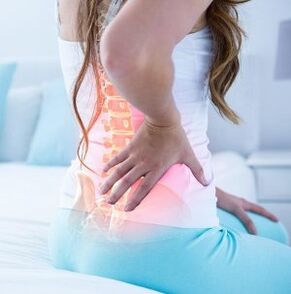Osteochondrosis- This is a complex of violations that occur in articular cartilage.Most often with damage to the intervertebral discs, which in most cases the neurological manifestations of osteochondrosis are associated in most cases.Drawing intervertebral discs, osteochondrosis leads to a significant deterioration in the quality of life of patients who are forced to constantly suffer from unpleasant symptoms.Manifestations of osteochondrosis are numerous, mainly consisting of periodically repeating pain in the neck, back, headaches, dizziness, ears noise, numbness sensations in various parts of the body and other unpleasant symptoms.
Causes and symptoms of osteochondrosis

Osteochondrosis has become widespread due to its specifics.It is based on the natural process of the biological aging of the body.Destroying over time, the intervertebral disk loses its security function.A narrowing of the intervertebral slit occurs, and the radicular nerves and blood vessels are clamped in it.This leads to severe pain, impaired motor function, headaches and other symptoms.
Among other causes of this disease can be called:
- sedentary, sedentary lifestyle;
- Excessive loads (lifting objects with a large mass, physical overload);
- autoimmune processes in the body (for example, red lupus, systemic scleroderma and other similar diseases);
- metabolic disorders with critical excess body weight;
- Calcium balance disorders in the body;
- pregnancy (provokes osteochondrosis in women due to the impoverishment of the body with calcium and inadequate distribution of increasing body weight relative to the vertical axis);
- spinal injuries.
The formidable complication of osteochondrosis is the formedA hernia of the intervertebral discwhich can require surgical intervention.Depending on the degree of complication, symptoms can vary from mild to high severity.
Neurological manifestations of osteochondrosis are most often factors leading to restriction of human disability.
TOThe main symptomsThe following can be attributed:
- pain in various parts of the spine;
- violations of organs that are innervated by the nerves of the affected area of the spine (for example, impaired secretion and peristalsis of the stomach with thoracic osteochondrosis);
- various kinds of vegetative disorders (violation of sweating, trophism or nutrition of tissues, skin temperature, etc.);
- headache and dizziness;
- Violations and loss of tendon (muscle) reflexes (they can be increased, reduced, uneven or not called at all). In each individual segment of the spine and other departments of the musculoskeletal system, specific (inherent only to this department) signs of violations.
So, withcervical osteochondrosisHeadaches are noted, intensifying during the turns of the neck, dizziness, flickering of “flies” in the eyes, fainting, etc.lumbar osteochondrosis- Acute pain (“shots”) in the back and lower, numbness of the legs, violations in the work of the genitourinary organs.
Osteochondrosis is often confused with other diseases with similar symptoms, soOnly a qualified neurologist can establish an accurate diagnosisAfter talking with the patient and conducting objective research.
Timely seeking a doctor avoids the development of complications!
Diagnosis and treatment methods
For the diagnosis of osteochondrosis, modern instrumental methods are used:
- magnetic resonance imaging (allows you to get pictures of the entire field of interest and identify the exact focus of the developed pathology);
- computed tomography with the visualization of bone-cheese structures and soft tissues;
- X -ray to determine the mutual arrangement of displaced vertebrae and axis of their displacement.
Depending on the results of the diagnosis, the causes and characteristic syndromes with which osteochondrosis proceeds, treatment methods are also selected.
The course of treatment is quite long.To get persistent results, he must include:
- limitation of mobility in the acute period;
- drug treatment;
- massage;
- Manual therapy after the exacerbation subsides.
For recovery after the disease, methods such asHirudotherapy(treatment with leeches), physiotherapy exercises, massage, thermal procedures.According to the indications, it is assignedPhysoalizationHowever, this method has a number of contraindications and requires medical control. At the present stage of the development of medicine, it is possible to achieve persistent remission and significantly reduce the risk of exacerbation, provided that all the doctor’s prescriptions are performed.For the prevention of the disease, the labor hygiene should be observed, not lifted, avoiding hypothermia, etc.






















